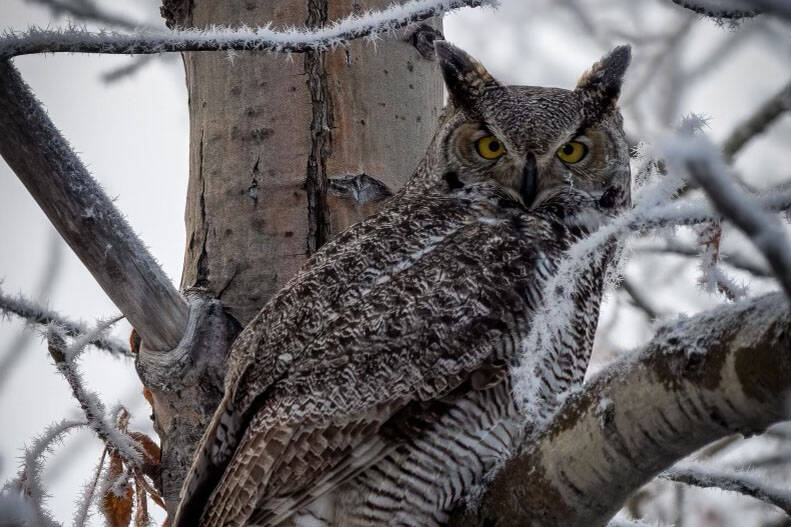By Kris Inman with Andy Loranger, Steve Miller, and Jeff Bouschor
Awaking to new snow and getting outside to welcome the day’s first light on a revived winter landscape is something a few of us at the Kenai National Wildlife Refuge reflected on this morning. It has been a particularly “favorite thing” for many of us since childhood.
The new snow brought our refuge manager outside for a morning walk. A great horned owl joined Andy in greeting the new day, perched high on a dying branch in one of the large and very old birch trees along his driveway. He found it pretty good company and impetus for reflecting on how much we have to be grateful for.
Many of us on the refuge enjoy spending time outdoors. We all have a deep connection to our work to conserve lands, waters and wildlife in their natural diversity and provide fish and wildlife related recreation for the enjoyment of all.
As new snow ushers in winter outdoor activities and the holidays, the Thanksgiving Day concludes, and each of us has our family traditions for the holidays. My family usually waited until December to set off for the woods to pick our perfect, maybe more like a Charlie Brown Christmas tree. It always seemed too long to wait for the festivities of Christmas though. We were fortunate. We could head out to the “back 40,” sometimes stopping off at the skating pond to check the ice, but often we stayed on task looking for the perfectly imperfect tree for the holidays.
When it was my turn to think about starting my family traditions, we were across the country from our own families. So, I was glad to embrace my friend’s tradition of getting a tree on Thanksgiving weekend and start the holidays sooner.
The Kenai National Wildlife Refuge opens Christmas tree-cutting from Thanksgiving Day, Thursday, Nov. 24 through Christmas Day, Sunday, Dec. 25. Trees are free for personal use. We have a few requirements, though.
The limit is one tree per household and no taller than 20 feet. Trees may be taken anywhere on the refuge with hand tools except within 150 feet of a road, lake, stream, trail, campground, or picnic area. No tree-cutting is permitted in the Refuge Headquarters/Visitor Center area and along Ski Hill Road. For aesthetic reasons, the public is asked to trim the stumps as close to the ground as possible.
Cutting a tree is not only part of the holiday traditions, but it is also one that gets us outside. For years, I have tried and failed to articulate what getting outside means to me. It is hard to put it into words, and even researchers have tried to quantifiably measure nature’s tie to human well-being.
Not surprisingly, they have found that interactions with nature develops and strengthens relationships with others. Outdoor experiences also give a feeling of satisfaction and accomplishment and changes mood, attitudes and even values.
Other studies have found that proximity to nature and the more remote and biodiverse areas are especially beneficial. This is something we find here on the Kenai and, to be honest, part of why we live here. Thankfully, for many of us working on the refuge, we are tasked with conserving biodiversity and stewarding the lands, water and wildlife for the well-being of us all.
Christmas tree-cutting offers many of these, and, if, as research suggests, we need 120 minutes per week to feel these benefits, it puts us well on our way toward achieving this goal.
As a scientist, I don’t need to quantify the benefits of nature. I am content with the immeasurable benefits I get from being outside. Even in simple pursuits, like cutting this year’s Christmas tree.
At times, my family is a bit like the Griswold’s looking for that bright beacon that would point us to the perfect tree, and other times, the end of the day would find us a bit like “The Beverly Hillbillies,” with a tree bigger than our truck.
We are fortunate that our holidays include family and friends. Each year turned out a new tree and a new place to go on the National Forest or out the backdoor of our friend’s small ranch in Montana. We would load up dogs and kids in the back of the pickup, bounce along the two-track road, and park at a spot that overlooked the valley. Then, each family would shoot off in different directions.
Returning later, to the same overlook, we would enjoy hot drinks, a bonfire, and check out the tree we each chose. The trees were sometimes narrow for a smaller living room, taller for a cathedral ceiling, but always the one that suited each of our homes. In some years, mainly when the kids were younger, the day’s outcome was up for grabs. Would someone be too cold, too hungry, too tired, or too slow or too fast in selecting a tree?
Regardless of what we brought to the day, each Christmas tree adventure stayed in my mind and brought me closer to friends and family and that undefinable feeling that clean, fresh, albeit cold air brings to my spirit.
Whether or not a Christmas tree is part of your Thanksgiving traditions, it is a time to be thankful. As the owl flew off on silent wings, Andy found himself thinking about that and how important it is to make the effort to be present, to rejoice in shared successes and to support each other when life’s more difficult challenges inevitably confront us.
Kris Inman is the Supervisory Wildlife Biologist, Andy Loranger is the refuge manager. Steve Miller is the deputy manager, and Jeff Bouschor is the fire management officer for the Kenai National Wildlife Refuge. Find out more about refuge events, recreation, and more at kenai.fws.gov or Facebook: https://www.facebook.com/kenainationalwildliferefuge and more Refuge Notebook articles (1999–present) at https://www.fws.gov/kenai-refuge-notebook.


